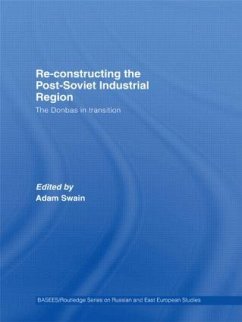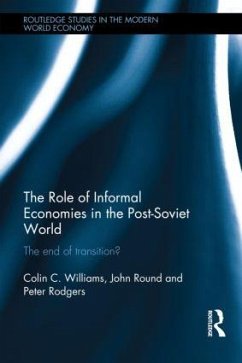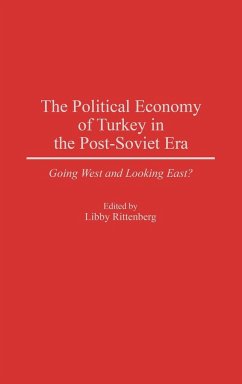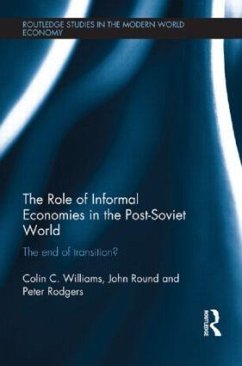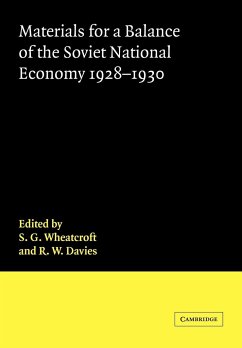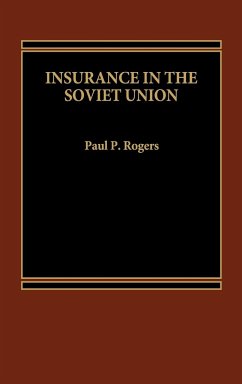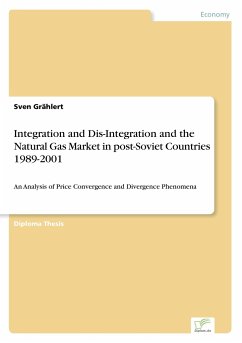
Integration and Dis-Integration and the Natural Gas Market in post-Soviet Countries 1989-2001
An Analysis of Price Convergence and Divergence Phenomena
Versandkostenfrei!
Versandfertig in 1-2 Wochen
68,00 €
inkl. MwSt.

PAYBACK Punkte
0 °P sammeln!
Diploma Thesis from the year 2002 in the subject Business economics - Economic and Social History, grade: 2,3, University of Tubingen (Wirtschaftswissenschaftliche Fakultät), language: English, abstract: Inhaltsangabe:Abstract:Integration and Dis-Integration or Dis-Integration and Integration or Dis-Integration and Re-Integration can be quite a word play. The Dis-Integration of the former Soviet Union (FSU) in the early 1990s marks a serious and unprecedented development in modern history. It was a break-up of the Union of Socialist Soviet Republics into fifteen newly independent states. Here...
Diploma Thesis from the year 2002 in the subject Business economics - Economic and Social History, grade: 2,3, University of Tubingen (Wirtschaftswissenschaftliche Fakultät), language: English, abstract: Inhaltsangabe:Abstract:
Integration and Dis-Integration or Dis-Integration and Integration or Dis-Integration and Re-Integration can be quite a word play. The Dis-Integration of the former Soviet Union (FSU) in the early 1990s marks a serious and unprecedented development in modern history. It was a break-up of the Union of Socialist Soviet Republics into fifteen newly independent states. Hereby, twelve states formed the Commonwealth of Independent States (CIS), a structure that was to keep some order over the break-up. Three countries the Baltics announced their total independence and declared no will to be part of the CIS. A later Integration or Re-Integration within the CIS is being actively discussed and debated up to now.
Several theories have evolved on the future of the region. Huntington s thesis predicts the Clash of Civilizations . He argues that the future battle over world politics will be over religious and cultural factors. Huntington predicts a split-up of the world along religious lines. In turn, Duncan rejects religion to be a factor in the current developments of the CIS. He limits Kuzio s idea of a division between the CIS into radicals and pragmatists among the two groups the Westernizers and Slavophiles .
Duncan concludes that there is generally a shift towards pragmatism in the foreign policies of the member states of the FSU. Disillusionment with the West is widespread. Most important factors that make countries tend towards a Westernist or Eurasianist course are linked to ethnicity and conflict. The author views the political regime and economic reforms are less important. Other studies focus more on the relationship between Russia and the other CIS countries. Alexandrova s arguments support the trend towards pragmatism. She adds that Moscow gave up the concept of re-integration, which it was convinced of in the first years of transition. Russia s foreign policy from Yeltsin to Putin shifted from Multilateralism to Bilateralism. Russian capital, invested in the near-abroad, is seen as a strong instrument to influence other CIS states and force them to Moscow s security policy.
Another -less recent- study on Integration and Disintegration from 1997 by authors of Brown University/U.S. and institutes from five newly independent states gives some outlook over the future ten years until 2006. Base for discussion were four rather extreme and abstract scenarios. Researchers and other experts from the region specialising in politics and security were confronted with the scenarios and asked to discuss and express their views on the future of the CIS. Economics did not play a major role in their debates over the tendencies within the region. In my work I will demonstrate that the energy sector, particularly the natural gas sector, plays an essential role in re-integrative tendencies. Logically, the largest successor of the FSU, the Russian Federation, plays a dominant role.
As part of my work I will review prices for natural gas in the CIS. Applying the theory of Purchasing Power Parity (PPP) enables me to compare prices internationally. Unfortunately, the data limit allows only a rough comparison. However, it supports trends developed in prior sections of the work. A statistical analysis is not used due to the insufficient data set.
The structure of my dissertation is as following: Section 2 summarizes the theoretical framework regarding integration and disintegration, based on findings of the 1997-study by authors of Brown University. In the progress of the dissertation I will illustrate that findings of the latter study are close to reality even today. After explaining the theoretical framework I will outline the hypothesi...
Integration and Dis-Integration or Dis-Integration and Integration or Dis-Integration and Re-Integration can be quite a word play. The Dis-Integration of the former Soviet Union (FSU) in the early 1990s marks a serious and unprecedented development in modern history. It was a break-up of the Union of Socialist Soviet Republics into fifteen newly independent states. Hereby, twelve states formed the Commonwealth of Independent States (CIS), a structure that was to keep some order over the break-up. Three countries the Baltics announced their total independence and declared no will to be part of the CIS. A later Integration or Re-Integration within the CIS is being actively discussed and debated up to now.
Several theories have evolved on the future of the region. Huntington s thesis predicts the Clash of Civilizations . He argues that the future battle over world politics will be over religious and cultural factors. Huntington predicts a split-up of the world along religious lines. In turn, Duncan rejects religion to be a factor in the current developments of the CIS. He limits Kuzio s idea of a division between the CIS into radicals and pragmatists among the two groups the Westernizers and Slavophiles .
Duncan concludes that there is generally a shift towards pragmatism in the foreign policies of the member states of the FSU. Disillusionment with the West is widespread. Most important factors that make countries tend towards a Westernist or Eurasianist course are linked to ethnicity and conflict. The author views the political regime and economic reforms are less important. Other studies focus more on the relationship between Russia and the other CIS countries. Alexandrova s arguments support the trend towards pragmatism. She adds that Moscow gave up the concept of re-integration, which it was convinced of in the first years of transition. Russia s foreign policy from Yeltsin to Putin shifted from Multilateralism to Bilateralism. Russian capital, invested in the near-abroad, is seen as a strong instrument to influence other CIS states and force them to Moscow s security policy.
Another -less recent- study on Integration and Disintegration from 1997 by authors of Brown University/U.S. and institutes from five newly independent states gives some outlook over the future ten years until 2006. Base for discussion were four rather extreme and abstract scenarios. Researchers and other experts from the region specialising in politics and security were confronted with the scenarios and asked to discuss and express their views on the future of the CIS. Economics did not play a major role in their debates over the tendencies within the region. In my work I will demonstrate that the energy sector, particularly the natural gas sector, plays an essential role in re-integrative tendencies. Logically, the largest successor of the FSU, the Russian Federation, plays a dominant role.
As part of my work I will review prices for natural gas in the CIS. Applying the theory of Purchasing Power Parity (PPP) enables me to compare prices internationally. Unfortunately, the data limit allows only a rough comparison. However, it supports trends developed in prior sections of the work. A statistical analysis is not used due to the insufficient data set.
The structure of my dissertation is as following: Section 2 summarizes the theoretical framework regarding integration and disintegration, based on findings of the 1997-study by authors of Brown University. In the progress of the dissertation I will illustrate that findings of the latter study are close to reality even today. After explaining the theoretical framework I will outline the hypothesi...





